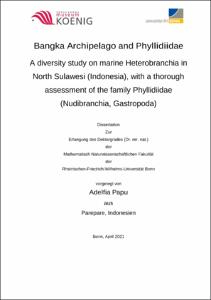Papu, Adelfia: Bangka Archipelago and Phyllidiidae : A diversity study on marine Heterobranchia in North Sulawesi (Indonesia) with a thorough assessment of the family Phyllidiidae (Nudibranchia, Gastropoda). - Bonn, 2021. - Dissertation, Rheinische Friedrich-Wilhelms-Universität Bonn.
Online-Ausgabe in bonndoc: https://nbn-resolving.org/urn:nbn:de:hbz:5-62903
Online-Ausgabe in bonndoc: https://nbn-resolving.org/urn:nbn:de:hbz:5-62903
@phdthesis{handle:20.500.11811/9195,
urn: https://nbn-resolving.org/urn:nbn:de:hbz:5-62903,
author = {{Adelfia Papu}},
title = {Bangka Archipelago and Phyllidiidae : A diversity study on marine Heterobranchia in North Sulawesi (Indonesia) with a thorough assessment of the family Phyllidiidae (Nudibranchia, Gastropoda)},
school = {Rheinische Friedrich-Wilhelms-Universität Bonn},
year = 2021,
month = jul,
note = {Sea slug diversity is reflecting the ecosystem and habitat diversity and also the health of these systems. Chapter 3 covers a new study location, Bangka Archipelago (BA). The substrate in BA is dominated by biogenic reefs and volcanic rocks, providing highly diverse and strongly structured habitats, including sea slugs. In total 149 species are recorded from this area now. 33 species recorded in my BA study are new to science. Members of the abundant tropical-subtropical nudibranch family Phyllidiidae are interesting with regard to the conspicuous colour (very popular for underwater photographers), chemical defense system (often investigated with regard to chemical compounds and of interest for pharmaceutical purposes) and the difficult taxonomic (therefore only few scientists have worked with this group). I combined molecular methods with thorough investigation of the external morphology. Maximum likelihood tree based on a concatenated dataset with 598 CO1 and 16S mitochondrial genes resulted in a large phylogeny of Phyllidiidae, which covers 32 species. Specimens from our expeditions can be assigned to 11 species of Phyllidia, 7 species of Phyllidiopsis, and 11 species of Phyllidiella. Six other species were added by extracting sequences from GenBank. With these integrative methods, external morphology, molecular and chemical analyses, we could demonstrate unknown cryptic variation or identify paraphyly in groups that up to now were considered monophyletic. We were therefore able to identify subspecies, or external variation within the species, or similar color patterns in not closely related species due to mimicry. I was able to resurrect Phyllidiella albonigra Quoy & Gaymard 1831 and synonymize Phyllidiopsis pipeki Brunckhorst, 1993 with Phyllidiopsis krempfi Pruvot-Fol, 1957. Additionally, the chemical analyses provide further evidence for dietary preference within the Phyllidiidae. The most problematic clade of Phyllidiidae is still Phyllidiella. Several other species were synonymized in the past with P. pustulosa, which was described with many external variations and many specimens with overlapping characters. All our specimens that clustered in a large clade, which we were able to assign to the “real” Phyllidiella pustulosa after re-analyses of type material, still split into subclades. The paratypes of P. nobilis are different species. One was very similar to one of our unnamed clades, but the name P. nobilis is not available for this clade, because of the synonymy of the holotype with P. pustulosa. In future analyses of Phyllidiidae, I advise to document all collected specimens from the dorsal and ventral side to preserve colour information, which is often lost in fixed material.},
url = {https://hdl.handle.net/20.500.11811/9195}
}
urn: https://nbn-resolving.org/urn:nbn:de:hbz:5-62903,
author = {{Adelfia Papu}},
title = {Bangka Archipelago and Phyllidiidae : A diversity study on marine Heterobranchia in North Sulawesi (Indonesia) with a thorough assessment of the family Phyllidiidae (Nudibranchia, Gastropoda)},
school = {Rheinische Friedrich-Wilhelms-Universität Bonn},
year = 2021,
month = jul,
note = {Sea slug diversity is reflecting the ecosystem and habitat diversity and also the health of these systems. Chapter 3 covers a new study location, Bangka Archipelago (BA). The substrate in BA is dominated by biogenic reefs and volcanic rocks, providing highly diverse and strongly structured habitats, including sea slugs. In total 149 species are recorded from this area now. 33 species recorded in my BA study are new to science. Members of the abundant tropical-subtropical nudibranch family Phyllidiidae are interesting with regard to the conspicuous colour (very popular for underwater photographers), chemical defense system (often investigated with regard to chemical compounds and of interest for pharmaceutical purposes) and the difficult taxonomic (therefore only few scientists have worked with this group). I combined molecular methods with thorough investigation of the external morphology. Maximum likelihood tree based on a concatenated dataset with 598 CO1 and 16S mitochondrial genes resulted in a large phylogeny of Phyllidiidae, which covers 32 species. Specimens from our expeditions can be assigned to 11 species of Phyllidia, 7 species of Phyllidiopsis, and 11 species of Phyllidiella. Six other species were added by extracting sequences from GenBank. With these integrative methods, external morphology, molecular and chemical analyses, we could demonstrate unknown cryptic variation or identify paraphyly in groups that up to now were considered monophyletic. We were therefore able to identify subspecies, or external variation within the species, or similar color patterns in not closely related species due to mimicry. I was able to resurrect Phyllidiella albonigra Quoy & Gaymard 1831 and synonymize Phyllidiopsis pipeki Brunckhorst, 1993 with Phyllidiopsis krempfi Pruvot-Fol, 1957. Additionally, the chemical analyses provide further evidence for dietary preference within the Phyllidiidae. The most problematic clade of Phyllidiidae is still Phyllidiella. Several other species were synonymized in the past with P. pustulosa, which was described with many external variations and many specimens with overlapping characters. All our specimens that clustered in a large clade, which we were able to assign to the “real” Phyllidiella pustulosa after re-analyses of type material, still split into subclades. The paratypes of P. nobilis are different species. One was very similar to one of our unnamed clades, but the name P. nobilis is not available for this clade, because of the synonymy of the holotype with P. pustulosa. In future analyses of Phyllidiidae, I advise to document all collected specimens from the dorsal and ventral side to preserve colour information, which is often lost in fixed material.},
url = {https://hdl.handle.net/20.500.11811/9195}
}






